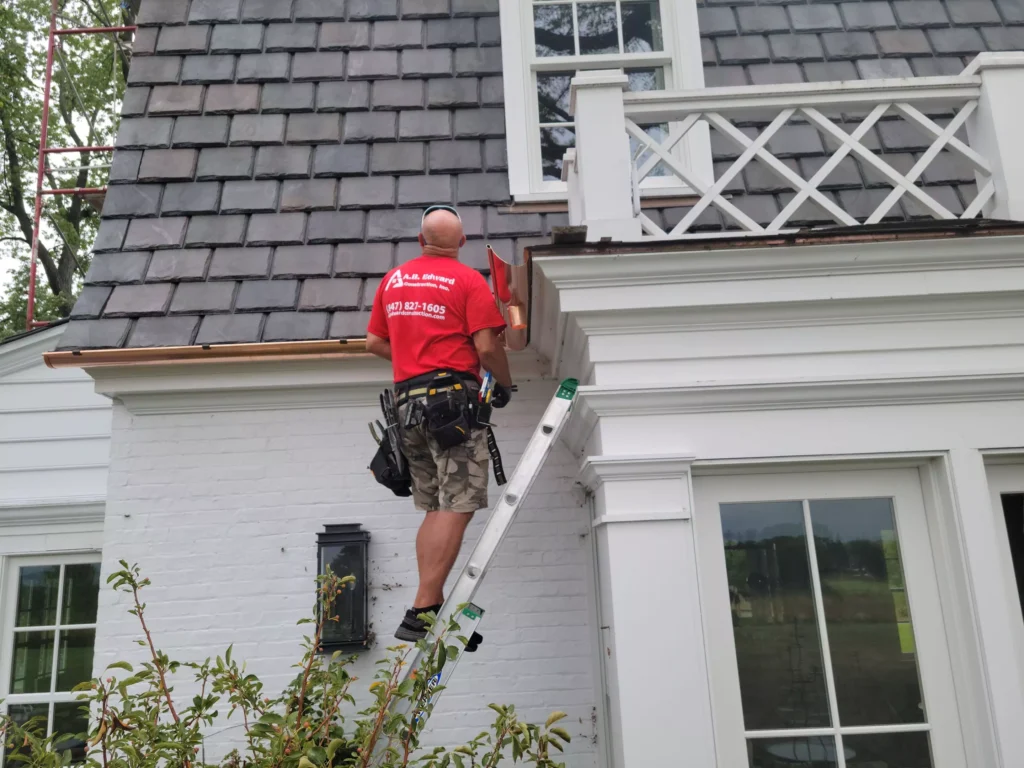Although no one sees sheathing on a daily basis, it is difficult to overestimate its role. Any roof covered with asphalt shingles, slate tiles, cedar shakes, TPO and a mass of other materials requires sheathing, because otherwise, the entire structure would collapse. Sheets of plywood or boards play a key role – they provide support for the outer layer of the roof (shingles), hold the thermal insulation in place, and are even responsible for transporting water vapor to the outside of the building. In this article, we’ll look at what happens when sheathing fails and in what situations it should be replaced. This should be known by anyone planning to have a roof replacement in the near future.
Table of Contents
Most Common Problems With Roof Sheathing
Mechanical Damage
Mechanical damage is the most common reason for replacing plywood sheathing. This is because intact sheathing retains its mechanical properties for a relatively long time, even if it is quite old. However, if a falling branch hits 30-year-old, moisture-weakened boards, the likelihood of them cracking or breaking apart is very high.
Mechanical damage to roof plywood can result from various external forces:
- Impact from Falling Objects: If you live in Tornado Alley or another high-wind area, such as Chicagoland, the risk of mechanical damage to your roof is significantly higher. Falling branches, wind-blown debris, loose bricks from chimneys, or hailstorms can cause cracks in the sheathing. The older the plywood, the more likely it is to sustain damage;
- Improper Installation of attic vents, A/C units and solar panels: As a roofing contractor, we frequently encounter cases where the installation of rooftop equipment has led to sheathing damage. Solar panels, in particular, pose a significant risk, as their installation requires drilling multiple holes in the roof. When a screw punctures the sheathing all the way through, it dramatically increases the chances of water infiltration, which, sooner or later, will lead to mold growth in the attic and wood rot.

Water Damage
Water poses a significant threat to roof sheathing, as it is typically untreated wood with low resin content. Moisture-related damage usually stems from one of two main causes:
- Leaks: as previously mentioned, leaks often result from improper installation of A/C units, solar panels, attic vents, or certain types of insulation, such as PIR or PUR foam boards. Additionally, cracked or delaminated asphalt shingles can create conditions where water runs down the roof and saturates the sheathing, leading to long-term damage;
- Moisture retention: an inefficient or damaged attic ventilation system can wreak havoc on your roof’s structure. The accumulation of warm, moist air near the sheathing will almost certainly cause the wood to absorb moisture, which in turn promotes mold growth, wood rot, and the delamination of plywood.
Wood Rot
It’s also essential to mention wood rot, which is a natural consequence of excessive moisture in the attic. Whether water infiltrates the sheathing from above—due to damaged asphalt shingles or cedar shakes—or from below, as a result of poor attic ventilation, the outcome remains the same.
The presence of both water and warmth creates the perfect conditions for wood rot to develop. As fungi and other microorganisms spread, the wood’s natural structure begins to break down—its fibers swell, weakening the sheathing and making it structurally unsound. In advanced stages, wood rot can lead to catastrophic failures, such as the roof collapsing under the weight of snow or even giving way when stepped on.
Presence of Mold and Mildew
Moisture accumulation doesn’t just lead to wood rot—it also significantly increases the likelihood of mold and mildew growth. Due to the low levels of natural light in attics and the generally higher temperatures compared to the outside, damp plywood becomes an ideal breeding ground for harmful fungi.
- Development: mold thrives in areas with poor air circulation, high humidity, and warm temperatures. Wet sheathing boards and plywood create the perfect environment for fungi to spread;
- Risks: Beyond structural concerns, mold and mildew can pose health risks to occupants and contribute to unpleasant odors within the attic space.

How to Prevent Sheathing Damage?
Let’s be honest—no plywood lasts forever. Even with slate roofs, where tiles can endure well over 100 years, the roof’s wooden structure often needs replacing long before the slate itself wears out. While tiles can be reused, the same doesn’t apply to deteriorated wood. However, there are effective ways to extend the lifespan of your sheathing:
- Use of high-quality materials: the thicker the plywood, the longer it will take before it starts rotting. Some roofing contractors offer plywood treated with additional protective coatings, but in our experience, these upgrades aren’t always worth the extra cost due to uncertain long-term benefits and the significant increase in roof replacement expenses.
- Regular inspections: Spotting minor damage doesn’t necessarily mean you need a full roof replacement. A small issue in the plywood suggests that a minor roof repair, typically costing under $2,000–3,000, might be enough. While this isn’t cheap, remember that a full roof replacement in the U.S. averages over $20,000;
- Prompt and professional repairs: temporary, low-budget fixes aren’t a good idea. Simply drying out plywood won’t make mold disappear, just as removing only a small portion of rotted plywood won’t prevent moisture from returning. Cutting corners on repairs often leads to even more expensive problems down the road;
- Proper ventilation: many plywood issues related to rotting and mold growth stem from poor attic ventilation. If the upper levels of your home feel excessively warm and humid, you should improve airflow as soon as possible to protect your sheathing from further moisture damage.

So When is it Time to Replace Sheathing?
irst and foremost, this should be assessed by your roofing contractor. Even if the sheathing doesn’t look great, it may still be performing its function well. However, there are certain signs that may indicate it’s time to consider replacing your roofing plywood:
Signs It’s Time to Replace Roof Sheathing
- Visible Damage: Look for cracks, warping, or other deformities in the plywood. Physical damage can compromise the roof’s strength. However, keep in mind that heavily damaged asphalt shingles do not necessarily mean that the plywood is worn out.
- Mold and Unpleasant Odors: The presence of mold or musty smells in the attic indicates moisture infiltration, leading to potential wood rot. These are clear signs that the sheathing may need replacement, at least in certain sections.
Factors Affecting Sheathing Durability
Several elements influence the longevity of your roof’s sheathing:
- Material quality: high-quality materials enhance durability of the entire structure, while cheap ones usually deteriorate significantly faster;
- Weather and climate: exposure to harsh weather conditions, such as heavy rain, snow, extreme heat, high moisture level and wind usually accelerate wear and tear on the roof sheathing;
- Type of rooftop material: cedar shakes and slate tiles tend to allow more water to seep through to the sheathing and underlayment compared to asphalt shingles, which create a tight, waterproof barrier on the roof.
Recommendations for Regular Inspections
You can also reduce the risk of sheathing damage through proper maintenance— in this case, consistency is key, along with avoiding superficial and short-sighted cost savings.
First and foremost, regularly schedule a roof inspections. Having your roof assessed every two or three years won’t generate high costs, but it will give you peace of mind that your plywood isn’t rotting and that mold or mildew isn’t developing in your attic. Unless you’re a roofer, you likely won’t be able to accurately assess your roof’s condition, which could lead to serious consequences.
Additionally, make sure to trim tree branches near your home. A falling limb can pierce through your roof in seconds, causing massive damage. While you can’t prevent hailstorms, you can absolutely take steps to prevent a tree from collapsing onto your house.



